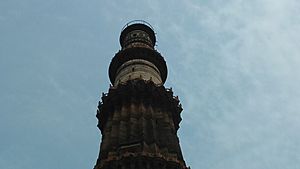Sikandar Lodi facts for kids
Quick facts for kids Sikandar Khan Lodi |
|
|---|---|
| Sultan of Delhi Sultan of the Lodi Dynasty |
|

The tomb of Sikandar Lodi
|
|
| 30th Sultan of Delhi | |
| Reign | 17 July 1489 – 21 November 1517 |
| Coronation | 17 July 1489 |
| Predecessor | Bahlul Khan Lodi |
| Successor | Ibrahim Khan Lodi |
| Born | 17 July 1458 Delhi |
| Died | 21 November 1517 (aged 59) Agra |
| Burial | Lodi Gardens, Delhi |
| Issue | Ibrahim Khan Lodi Mahmud Khan Lodi |
| Dynasty | Lodi dynasty |
| Father | Bahlul Khan Lodi |
| Religion | Sunni Islam |
Sikandar Khan Lodi was a powerful ruler of the Delhi Sultanate from 1489 to 1517. Born Nizam Khan, he was the second and most successful sultan of the Lodi dynasty. He took over after his father, Bahlul Khan Lodi, passed away.
Sikandar Lodi worked hard to get back lands that used to be part of the Delhi Sultanate. He managed to make the Lodi kingdom much bigger. He was also a talented poet who wrote many verses in the Persian language.
Becoming Sultan
Sikandar was the second son of Sultan Bahlul Lodi. His father had started the Lodi ruling family in the Delhi Sultanate. Sikandar became Sultan in July 1489.
Sikandar's Rule

Sikandar Lodi was a very skilled leader. He made trade better across his kingdom. He expanded the Lodi rule into areas like Gwalior and Bihar. He also made a peace agreement with Alauddin Hussain Shah, the ruler of Bengal.
In 1503, Sikandar Lodi ordered the building of a new city. This city is known today as Agra. He moved his main base to Agra later, as it was closer to some areas he wanted to control.
Battles with Gwalior
When Sikandar Lodi became Sultan, he faced challenges from Raja Man Singh Tomar of Gwalior. Raja Man Singh had paid tribute to Sikandar's father to avoid war.
In 1500, Raja Man Singh gave shelter to some rebels from Delhi. These rebels had tried to overthrow Sikandar Lodi. So, Sikandar decided to attack Gwalior to punish Raja Man Singh and expand his land.
In 1501, Sikandar captured Dholpur, a town connected to Gwalior. Its ruler fled to Gwalior. Sikandar then marched towards Gwalior. But an illness spread in his army, forcing him to stop. Raja Man Singh used this chance to make peace. He sent his son with gifts and promised to send away the rebels. Sikandar Lodi agreed, and Dholpur was returned.
In 1504, Sikandar Lodi started fighting Gwalior again. He captured the Mandrayal fort. Many of his soldiers got sick, so he had to return to Delhi. Later, he moved his base to Agra, which was closer to Gwalior.
He captured Dholpur again and attacked Gwalior. From 1505 to 1506, Lodi raided the areas around Gwalior. But he could not capture the strong Gwalior Fort. Raja Man Singh used clever hit-and-run tactics. Lodi's army ran out of food because he had destroyed crops. He had to give up the siege. On his way back, Raja Man Singh attacked his army, causing many losses.
Sikandar then focused on capturing smaller forts around Gwalior. He took Uditnagar fort in 1507. In September 1507, he attacked Narwar and captured it after a year-long siege. Sikandar Lodi continued to be busy with other conflicts. He planned to capture Gwalior in 1516, but he became ill. Both Raja Man Singh Tomar and Sikandar Lodi died in 1516 and 1517, respectively.
Religious Views
The Lodi Sultans were Muslims. Sikandar Lodi's mother was Hindu, and he tried to show he was a strong Muslim ruler. He made some strict religious decisions. He ordered the destruction of some Hindu temples. He also allowed the execution of a Brahmin who said Hinduism was as true as Islam.
Sikandar Lodi also stopped women from visiting the tombs of Muslim saints. He banned a yearly procession for a Muslim martyr named Salar Masud.
Before Sikandar, local leaders handled legal matters in small towns. The Sultan would ask Islamic law scholars for advice. Sikandar set up Islamic law courts in many towns. This allowed judges (called qazis) to apply Islamic law to more people. These courts were mainly for Muslims but were also open to non-Muslims for things like property disputes.


